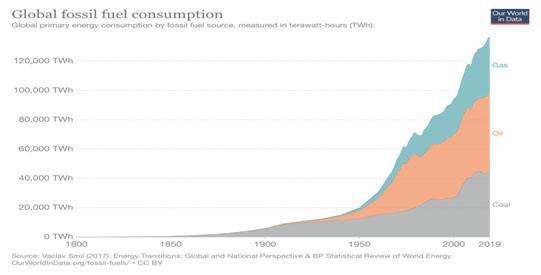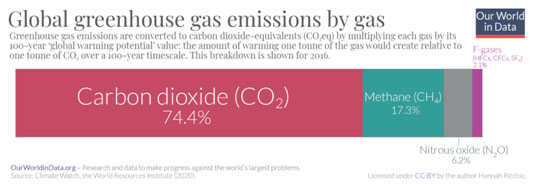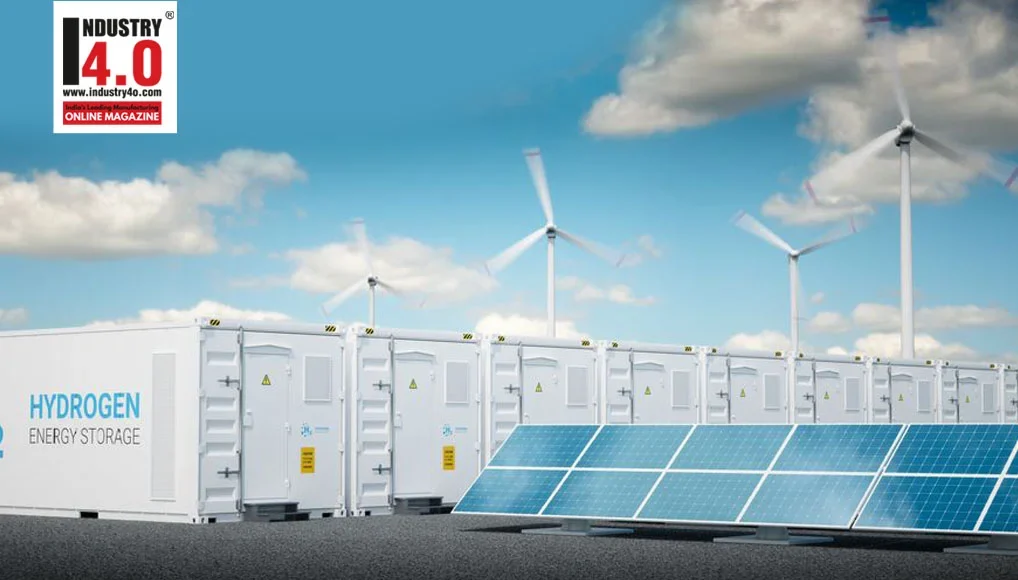Hydrogen – A Clean Energy Source
CLIMATE CHALLENGE
For most of human history our ancestors relied on very basic forms of energy: human muscle, animal muscle and the burning of biomass such as wood or crops. But the Industrial Revolution unlocked a whole new energy resource: fossil fuels.
Fossil fuels (Coal, Oil, Gas) have been a fundamental driver of the technological, social, economic and development progress which has followed the industrial revolution and continue to, play a dominant role in global energy systems.

Fig 1 – Global Fossil Fuel Consumption Pattern(Credit – Our world in Data)
But fossil fuels also come at a cost to us – individually and as a society. When burned fossil fuels produce carbon dioxide (CO2)– the most significant contributor to greenhouse gas emissions and leading factor for global warming. Combustion of fossil fuels also significantly contribute to land degradation, water pollution, spread of deadly diseases such as asthma and cancer leading to millions of premature deaths– leaving a question mark on the future of our next generations.

Fig 2 – Global greenhouse gas emissions by gas(Credit – Our world in Data)
NEW CLIMATE AMBITION
In order to have a sustainable future for our next generations, we needed to find a mechanism to not only control but reverse the trends of global warming and climate change. To this effect, as of 2020, 196 states and the European Union have signed the Paris Agreement, a legally binding international treaty dealing with gashouse gas emission under the United Nations Framework Convention on Climate Change (UNFCCC).
 The goal for the Paris Agreement is to limit global warming to well below 2, preferably to 1.5 degrees Celsius, compared to pre-industrial levels and itworks on a 5- year cycle of increasingly ambitious climate action carried out by countries.
The goal for the Paris Agreement is to limit global warming to well below 2, preferably to 1.5 degrees Celsius, compared to pre-industrial levels and itworks on a 5- year cycle of increasingly ambitious climate action carried out by countries.
In the sixth assessment cycle, the United Nations body responsible for assessing the science related to climate change – Intergovernmental Panel on Climate Change (IPCC) published a Special Report on Global Warming of1.5°C.
The report finds that limiting global warming to 1.5°C would require “rapid and far-reaching” transitions in land, energy, industry, buildings, transport, and cities. Global net human-caused emissions of carbon dioxide (CO2) would need to fall by about 45 percent from 2010 levels by 2030, reaching ‘net zero’ around 2050. This means that any remaining emissions would need to be balanced by removing CO2 from the air.

Fig 3 – CO2 emissions required to achieve 1.5°C (Credit – Our world in Data)
TOWARDS NET ZERO
Moving towards net zero is a daunting task for every state – be it the developed ones or the developing ones. And the foremost challenge in the journey is eliminating the usage of fossil fuel and moving to a carbon neutral/ clean fuel mix consisting of renewables, carbon neutral bio fuels, nuclear etc.
An Alternative Fuel – Hydrogen
Hydrogen is the lightest element in periodic table (atomic number 1) and an atom of it consists of only one proton and one electron. It does not occur naturally on earth but is found in abundance in combination with other elements – notably in hydrocarbons, water.
The interest in Hydrogen as a clean and alternate fuel source stems from below facts:
- when consumed in fuel cell produces only water (i.e., zero emissions)
- has potential for domestic production
- fast filling time (e.g., retail dispensers can fill 10,000 psi tanks for FCEV’s in 5 mins)
- fuel cell’s high efficiency (e.g., a fuel cell coupled with an electric motor is two to three times more efficient than an internal combustion engine running on gasoline)
Hydrogen is an energy carrier that can be used to store, move, and deliver energy produced from other sources. NASA has been using hydrogen to conduct space missions since 158.
Hydrogen provides energy security as it can be produced domestically by the following methods:
- Thermal processes:This is the most common method yielding 95% of today’s hydrogen. It involves steam reforming – a high-temperature process in which steam reacts with a hydrocarbon fuel (such as natural gas, diesel, renewable liquid fuels, gasified coal, or gasified biomass)to produce hydrogen.
- Other hydrogen producing methods include
- Electrolytic processes to separate hydrogen from water molecules
- Solar/ Light driven processes such as photo biological, photo chemical and thermo chemical process to generate hydrogen
- Biological processes using microbes to produce hydrogen via bio reactions
Current State of Hydrogen
Based on the generation method, hydrogen can be classified into Grey, Brown, Blue and Green hydrogen.

Green hydrogen is the ideal long-term, low-carbon way to produce hydrogen.
*CCS – Carbon Capture and Storage
Uses of Hydrogen
Some key use cases for hydrogen are listed below
- Power Generation: Hydrogen can be used to
- store renewable energy
- increase power system flexibility in gas turbines in conjunction with Ammonia
- Buildings: Hydrogen can be used
- for heating in buildings densely populated cities, leveraging existing gas networks
- in hydrogen-based boilers
- Transport: Hydrogen can be used in
- fuel cell vehicles (FCV) or fuel cell electric vehicles (FCEV)
- shipping
- aviation
Outlook for Hydrogen
Over the years hydrogen technologies have caught the imagination and interest of policy makers across continents and have gained momentum. Below are key examples how hydrogen is gain political momentum as part of the wider climate change / zero carbon agenda.
- North America
- US Energy Policy Act (EPAct) of 1992established Hydrogen as an alternate fuel source.
- California is leading the country in building hydrogen based fueling station for Fuel Cell Electric Vehicles (FCEVs) through it’s Clean Transportation Program, having opened 43 retail hydrogen stations for public and having 19 more in various stages of construction and planning
- Europe
- In 2020, EU has set up an ambitious target for Hydrogen and it is now expected to provide at least 13% of the final energy demand by 2050 in Europe (Source: A hydrogen strategy for a climate-neutral Europe). The Strategy aims to have at least 40GW of electrolyzer installed by 2030 and up to 10 million tons of green hydrogen.
- In UK, the Cumbrian trail led by DNVGL is exploring whether the gas could remove emissions from some of the most polluting sectors of the economy – heating, heavy industry and long-distance transport
- A 2020 DNVGL study (Heading for Hydrogen) reports that
- 42% of senior oil and gas professionals (compared to 19% in ’19) surveyed expected their organization to invest or develop hydrogen in the year ahead, and
- 52% of senior oil and gas professionals expect hydrogen to be a significant part of the energy mix within just 10 years
- Asia -Pacific
- Japan’s Hydrogen Roadmap has an ambitious goal of
- 200K fuel cell vehicles by 2025, and 800k by 2030 from current 3,800 fuel vehicles
- 320 hydrogen refueling stations by 2025, and 900 by 2030 from current 135 hydrogen refueling stations
- 1,200 fuel buses by 2030 from current 91 fuel cell buses and 250 fuel cell forklifts
- Korea announced its Hydrogen Economy Roadmap in January 2019, targeting by 2040
- FCEV passenger car production capacity of 6.2 million and
- the deployment of 40,000 FC buses, 30 000 FC trucks and 1,200 HRSs
- Australia’s National Hydrogen Strategy defined 57 actions in areas such as regulation, infrastructure, mobility and R&D with the aim of positioning it as a world leader in hydrogen production and exports
- India is in nascent stage of green Hydrogen economy. FTI consulting’s 2020 India’s Green Hydrogen Roadmap report proposes
- National Hydrogen Policy and Roadmap by 2021 to be prepared
- Creation of IndiaH2 Hydrogen Taskforce and Workgroups to implement roadmap
- Green Hydrogen Investment Fund of $100m to be deployed through 2025, with a larger Hydrogen Fund to be raised for 2025-2030
- National aspiration for a 4% hydrogen share in national energy mix by 2030
- Japan’s Hydrogen Roadmap has an ambitious goal of
Key Challenges
Hydrogen as analternate fuel source has some economic and technical detriments that currently limit its viability as a serious replacement for fossil fuels. These include, but are not limited to:
- Storage: From a transportation perspective, the biggest technical challenge is how to store the amount of hydrogen required for a conventional driving range (>300 miles) within the vehicular constraints of weight, volume, efficiency, safety, and cost.
- Production Costs
- Fuel Cell : To be competitive in the marketplace, the cost of fuel cells will have to decrease substantially without compromising performance.Unlike a battery, where most of the cost comes from the raw materials used to make it, the most expensive part of a fuel cell is in manufacturing the fuel cell stack itself—not the materials to produce it.
- Stations : The cost to build and maintain hydrogen stations also needs to decrease for the market to be able to support a hydrogen economy.
- Infrastructure : The high cost of hydrogen production, low availability of the hydrogen production systems, and the challenge of providing safe production (hydrogen is highly flammable and flames are almost invisible to naked eye) and delivery systems are all early penetration barriers.
Lot of research and development is already underway to address these drawbacks.
CONCLUSION
The road to green hydrogen over next 2-3 decades is ambitious and altruistic. But since 2018 hydrogen have picked up the right political momentum gaining entry to key nations clean energy roadmap and to key forums such as G20. With Covid-19 striking in 2020 the priorities of nations and industries have temporarily changed, but the ambitions remain right and is expected to pick up pace as the world strives to recover to normalcy.
Key Takeaways
The acceleration in success of hydrogen becoming a viable clean energy alternative will be determined
- by extent of international co operation in terms of policy, technology exchange and funding, and
- by cross-industry factors
- the extent to which green hydrogen replaces grey and brown hydrogen in the industrial applications
- demand in new sectors such as gas grid injection, electricity storage, industrial and commercial applications
- scale-up, cost reductions and improvements (in efficiency, lifetime and process integration) of cross-cutting technologies such as electrolysers, fuel cells and hydrogen production with carbon capture and utilization or storage (CCUS)
About the Authors:
Delivery Project Executive at IBM
Pinaki Bhattacharya has 17 years of extensive experience in digital transformations, industry consulting, managing P&L, and people management. He has multiple technical disclosures published. He is passionate about education at grass root level and volunteers himself as an Educator at e-Vidyaloka.
He is a Strategic Advisor to Charity IT Association – CITA. He is also a Fund Raiser & Social Investor at Rang De
He is bestowed with the following Licenses & Certifications :
https://www.linkedin.com/in/pi
He can be Contacted at :
LinkedIn : pi
Twitter : Globetrott
E-mail : [email protected]

Mr. Rajeev Mittal,
Associate Partner with IBM Consulting
Rajeev Mittal has 22+ years of extensive experience with services, software development, development processes, client relationships, and project & people management.Led Transformation programs for client in Digital, Analytics, Cloud, Automation, Dev Ops, Agile development. He is also a Certified Professional Google Cloud Architect.
He is bestowed with the following Licenses & Certifications :
https://www.linkedin.com/in/mr
He can be Contacted at :
LinkedIn : mr
Email : [email protected]
Mobile : +91 9811 542076
Twitter : mrajeev74

Mr. Ajay Srivastava
Sr. Industry Consultant (EE&U) at IBM Consulting
Ajay is a diverse professional with experience in Analysis, design, Testing, Team Management, Onsite-Offshore Co-ordination. He has techno-functional experience on Siebel (7.x/8.x) customized implementation for key Telco’s like IDEA, BT (British Telecom UK) & Telefonica (Spain).
Ajay has experience in understanding Business processes and provide requirement analysis, writing functional specifications and high level design. He also has implementation experience using all stages of SDLC and Agile methodologies.
He is Bestowed with the following Licenses & Certifications :
https://www.linkedin.com/in/aj
He can be contacted at :
LinkedIn : aj
BIBLIOGRAPHY
In our research we have used information and data sources from the below websites:
NASA and Hydrogen
International Energy Association (IEA)
UK Hydrogen and Fuel Cell Association
Japan Hydrogen Roadmap summary and detailed report
FTI Consulting report on India
https://www.renewableenergyworld.com/types-of-renewable-energy/hydrogen/#gref
https://gmsciencein.com/2018/05/10/hydrogen-fuel-challenge/
https://www.iea.org/reports/the-future-of-hydrogen










